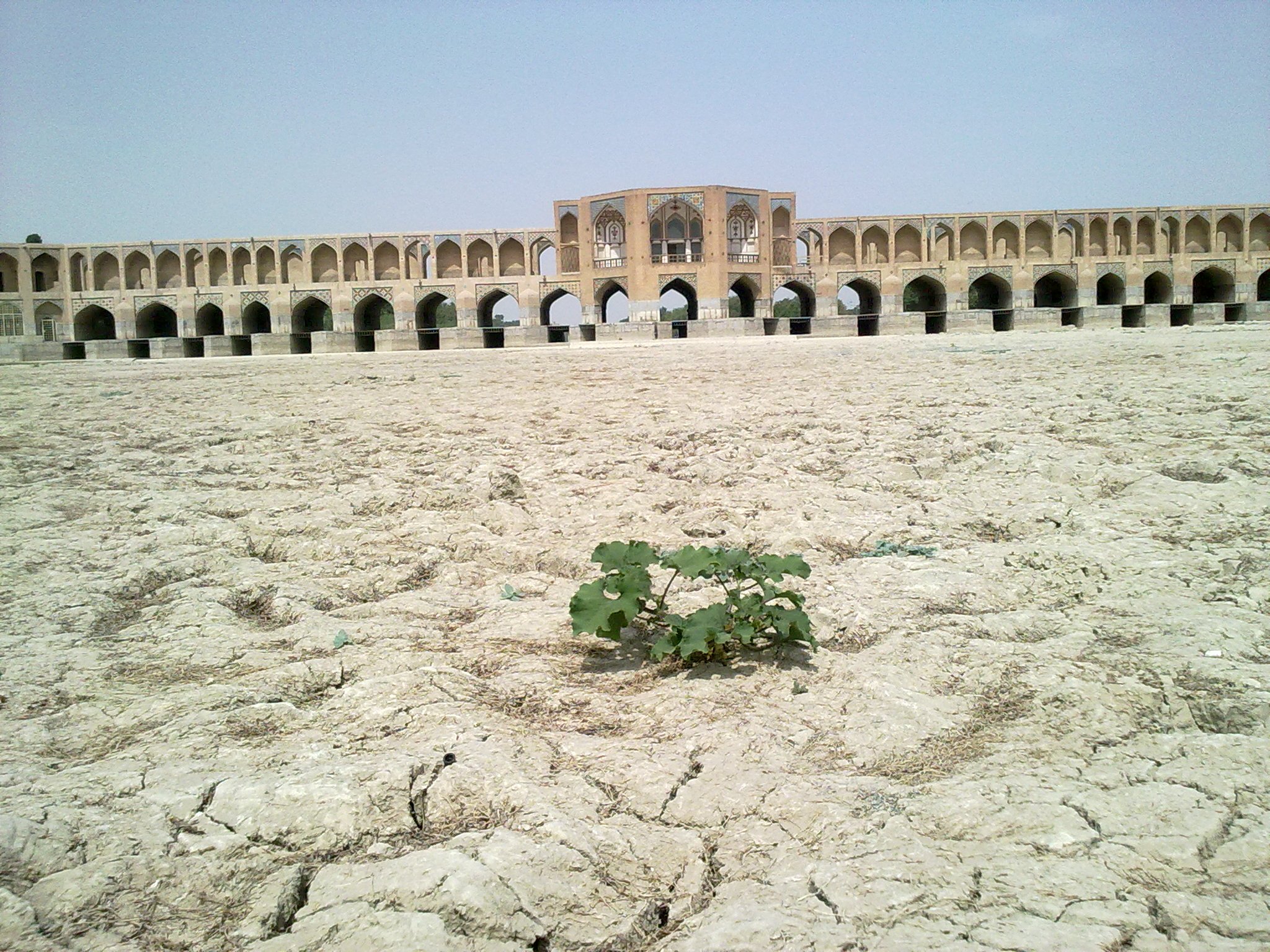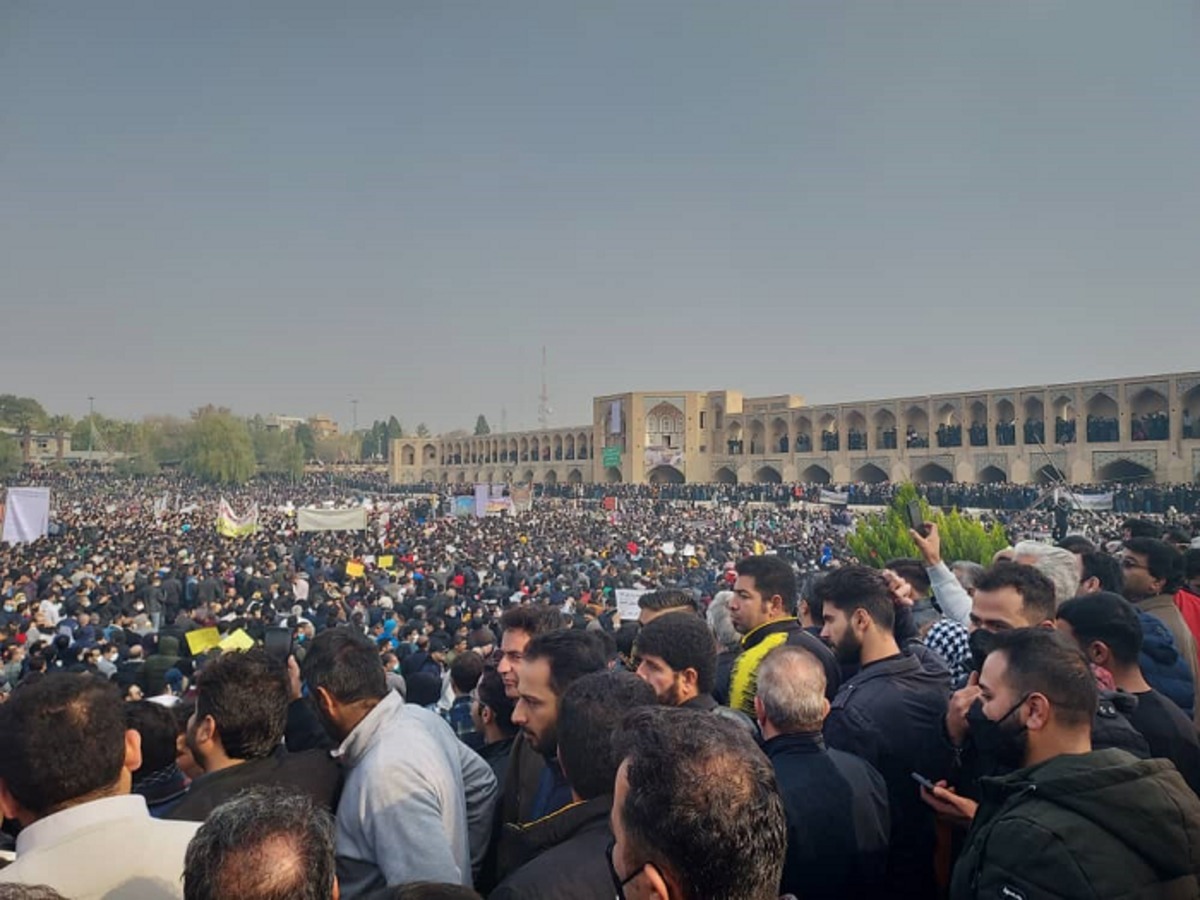Since 8 November, thousands of farmers have been protesting in Isfahan, Iran, over the drying up of the Zayanderud river, the major river in the province. They have been calling for the distribution of water reserves to farmers. Having been ignored by the regime, farmers occupied the dried-up riverbed in front of Khaju bridge. In the early morning of 25 November, riot police set the farmers’ tents ablaze: the beginning of a government crackdown against the increasingly militant protests. Clashes between protesters and the regime continued for three days, with 210 arrested, 20 injured and three deaths confirmed.
These protests started with a rally outside the regional water organisation’s headquarters. One farmer held a speech attacking the body, saying that: “these gentlemen here are selling water, taking the people’s property, both legally and illegally”. One woman gave a speech that went much further, openly attacking the regime’s calls for national unity in the face of US sanctions, saying that “the real enemies of Iran are within, they are the rich and powerful”. Another speaker summarised the militant mood by saying: “If all of us farmers in Isafan are killed, this protest is still worthwhile for future generations not to be ashamed of us, for not defending our rivers”.
The protests continued daily, with slogans such as: “be ready, with an army, be ready”, calling on people to join the protests, and pledging “we will not return home until there is water in the river.” On 11 November, farmers started occupying the dried-up river bed in front of Khaju, calling for citywide protests on 17 November. Already, many workers, especially the youth, participated in protests, tens of thousands strong. New slogans emerged that generalised the farmers’ plight, including “the people and the farmers are united”, and “equality of justice, this is the demand of the whole nation”.
The crisis of leadership
At first, the government attempted to sow confusion among the ranks of the protesters. Isfahan’s MP and the local government demagogically blamed the export of water to the province of Yazd and supposed overuse of water upriver in the province of Chaharmahal-Bakhtiari for the drying up of Zayanderud. This diversion had an initial effect, especially in the rural areas. In one such protest, farmers destroyed water pipelines to the province of Yazd. But demonstrators gathering in Isfahan rejected this narrow regional view with one speaker explaining: “It is not the fault of Yazd or Chaharmahal province but the water thieves [referring to the government]. Their mismanagement has destroyed our river and now the little we have they give to their other thief friends.”
The minister of energy said: “You have to be patient”. But the protesters ignored the calls for calm, and the demonstrations only grew, with militant slogans appearing such as: “Traitorous minister! You have displaced us! You destroyed my house! Death to you!” On 16 November, the government offered financial compensation and a small increase in allotment from water reserves, concessions which were rejected by the farmers. One protester, referring to previous compensation for drought, explained: “Farmers in Isfahan do not want charity. In 2018, the farmers’ water was also stolen, they were promised 180 billion toman worth of compensation, but the money only arrived a month ago making it worthless in the face of inflation.”
The regime was wary of provoking an uprising similar to the one in Khuzestan province during August, which was sparked precisely by attempts to suppress protesting farmers, leading to a three-day regional uprising. Instead, as early as 15 November the regime prepared for a confrontation; building up their security presence in the city but avoiding clashes. Their presence was met with speeches by the farmers, calling on the police to join the protesters: “Police, we do not have water for agriculture today. Your children will not have water to drink tomorrow. Do you want to stand in front of us? Come on! We have come here. We have announced our readiness to fight. If you want to stand in front of us, we are fully prepared! We are here to realise the will of the people!”
During the crackdown, the protests did indeed spread to Chaharmahal-Bakhtiari Province, with around 10,000 participating, but they were quickly quelled, with the government declaring martial law and placing a military governor in charge. The slogans in Isfahan turned openly political, including: “Death to Khamenei”, and “all these soldiers have come for [President] Raisi’s war!” This shows the revolutionary mood building up in society, as evidenced by other radical protest movements and strikes in recent years. The masses are getting ready to move into action. But the movement still suffers from a crucial weakness: a lack of bold leadership. Since 2018, there have been four major uprisings, and all have failed. Without independent working-class organisations, without the necessary leadership, they became isolated and were swiftly suppressed.
Workers and farmers unite! Down with the Islamic Republic!
The water crisis has become part and parcel of the Iranian class struggle. It has been caused both, in part, by climate change, which has led to a sharp reduction of rainfall; but also by shortsighted capitalist exploitation of Iran's water resources. Already, the 2019 parliamentary report showed that, in the next five years, 104 cities will experience water stress, and 38 percent of these will experience acute water stress. Farmers are the first to be affected, with half being unemployed in Isfahan, Yazd, and Chaharmahal and Bakhtiari provinces due to water scarcity.
 The water crisis has become part and parcel of the Iranian class struggle / Image: WMO twitter
The water crisis has become part and parcel of the Iranian class struggle / Image: WMO twitter
This crisis is completely avoidable. The regime does not lack the technology or resources. It is simply more interested in enriching itself than investing these resources. As workers of the Haft Tappeh union (who have been on strike for months) explained: “It would have been possible to change all the agricultural properties of the whole country with modern irrigation. But who is going to provide these facilities?” This lack of investment is concurrent with a general economic crisis, which is seeing inflation soar, and over half of the population immersed in poverty. Farmers and workers alike face unemployment and poverty caused by the parasitic Iranian capitalist class. All the while, the Iranian capitalist class has increased its wealth in the past year by 32 percent.
The farmers and workers must unite against their common enemy, the capitalist class and its Islamic Republic. The first steps toward such a unity can be seen in the statement of solidarity by 30 workers’ organisations to Isfahan farmers, issued during the crackdown: “Environmental degradation is one of the consequences of water scarcity and of the myriad disasters caused by the capitalist profiteering of the government”.
The workers of Haft Tappeh went further and explained, “The suffering created by the water shortage imposed on farmers and the general public comes from the same source as the suffering of the workers, teachers and toilers: the minority that stands on top of society and benefits from everything we do! Those at the top reap the benefits from our lives, our water resources, our oil and gas, our mines, our nature, our labour...They are the capitalist class!” The statement also points to a clear way forward, stating that: “Our answer is that we have no choice but to unite and organise to get our rights.”
Campaign for a political struggle! For a general strike!
Since 2018, there have been constant strikes, farmers’ protests and even uprisings, but the Islamic Republic remains in power. This is only because of a lack of leadership, specifically the leadership of the organised working class. The Iranian working class has the power to unite all the brewing struggles, and bring the ruling class to its knees.
Already, through economic struggle, various independent workers’ organisations have developed. This is an important step forward, but the current situation demands more than statements of solidarity between separate workers in struggle. It demands a united fight of the entire Iranian working class and poor against the capitalist class and its regime: the Islamic Republic. The regime is nearly completely discredited, and is only able to remain in power through suppression.
For their revolutionary potential to be realised, a general programme is needed for Iran's workers and the farmers, in order to fuse the fragmented strikes and protests across the country into a mighty national movement. This would include economic demands such as the reversal of all austerity measures; living wages and pensions that increase with inflation; an extensive programme of public works to repair and develop the country’s crumbling infrastructure, including irrigation; the renationalisation of all privatised companies under workers’ control; and the introduction of workers’ control throughout the state-owned economy, including control of Iran’s water by farmers and workers. Political demands cannot be ignored and must include a call for the downfall of the Islamic Republic, the convocation of a constituent assembly, and democratic rights such as the rights to strike, protest and assembly.
Such a programme would lay the foundation for a general movement against the regime, preparing the ground for the revolutionary transformation of society. Until then, strikes, protests and even uprisings will continue, but will either fizzle out or be suppressed by the regime; only to return emboldened at a later date. A decent existence for Iran’s working class, peasantry and youth hinges on building the leadership of the future Iranian Revolution.

